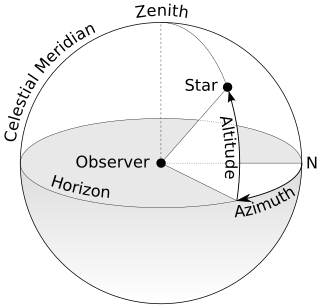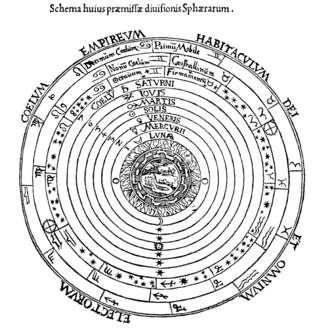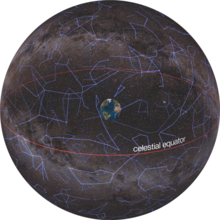
In astronomy, declination is one of the two angles that locate a point on the celestial sphere in the equatorial coordinate system, the other being hour angle. The declination angle is measured north (positive) or south (negative) of the celestial equator, along the hour circle passing through the point in question.

The ecliptic or ecliptic plane is the orbital plane of Earth around the Sun. From the perspective of an observer on Earth, the Sun's movement around the celestial sphere over the course of a year traces out a path along the ecliptic against the background of stars. The ecliptic is an important reference plane and is the basis of the ecliptic coordinate system.

Right ascension is the angular distance of a particular point measured eastward along the celestial equator from the Sun at the March equinox to the point in question above the Earth. When paired with declination, these astronomical coordinates specify the location of a point on the celestial sphere in the equatorial coordinate system.

In astronomy, coordinate systems are used for specifying positions of celestial objects relative to a given reference frame, based on physical reference points available to a situated observer. Coordinate systems in astronomy can specify an object's position in three-dimensional space or plot merely its direction on a celestial sphere, if the object's distance is unknown or trivial.

The equatorial coordinate system is a celestial coordinate system widely used to specify the positions of celestial objects. It may be implemented in spherical or rectangular coordinates, both defined by an origin at the centre of Earth, a fundamental plane consisting of the projection of Earth's equator onto the celestial sphere, a primary direction towards the March equinox, and a right-handed convention.

The horizontal coordinate system is a celestial coordinate system that uses the observer's local horizon as the fundamental plane to define two angles: altitude and azimuth. Therefore, the horizontal coordinate system is sometimes called the az/el system, the alt/az system, or the alt-azimuth system, among others. In an altazimuth mount of a telescope, the instrument's two axes follow altitude and azimuth.

In astronomy, the ecliptic coordinate system is a celestial coordinate system commonly used for representing the apparent positions, orbits, and pole orientations of Solar System objects. Because most planets and many small Solar System bodies have orbits with only slight inclinations to the ecliptic, using it as the fundamental plane is convenient. The system's origin can be the center of either the Sun or Earth, its primary direction is towards the March equinox, and it has a right-hand convention. It may be implemented in spherical or rectangular coordinates.
The cosmological model of concentricspheres, developed by Eudoxus, Callippus, and Aristotle, employed celestial spheres all centered on the Earth. In this respect, it differed from the epicyclic and eccentric models with multiple centers, which were used by Ptolemy and other mathematical astronomers until the time of Copernicus.

The celestial spheres, or celestial orbs, were the fundamental entities of the cosmological models developed by Plato, Eudoxus, Aristotle, Ptolemy, Copernicus, and others. In these celestial models, the apparent motions of the fixed stars and planets are accounted for by treating them as embedded in rotating spheres made of an aetherial, transparent fifth element (quintessence), like gems set in orbs. Since it was believed that the fixed stars did not change their positions relative to one another, it was argued that they must be on the surface of a single starry sphere.

In astronomy, the fixed stars are the luminary points, mainly stars, that appear not to move relative to one another against the darkness of the night sky in the background. This is in contrast to those lights visible to naked eye, namely planets and comets, that appear to move slowly among those "fixed" stars.

Spherical astronomy, or positional astronomy, is a branch of observational astronomy used to locate astronomical objects on the celestial sphere, as seen at a particular date, time, and location on Earth. It relies on the mathematical methods of spherical trigonometry and the measurements of astrometry.

Ancient Greek astronomy is the astronomy written in the Greek language during classical antiquity. Greek astronomy is understood to include the Ancient Greek, Hellenistic, Greco-Roman, and late antique eras. Ancient Greek astronomy can be divided into three primary phases: Classical Greek Astronomy, which encompassed the 5th and 4th centuries BC, and Hellenistic Astronomy, which encompasses the subsequent period until the formation of the Roman Empire ca. 30 BC, and finally Greco-Roman astronomy, which refers to the continuation of the tradition of Greek astronomy in the Roman world. During the Hellenistic era and onwards, Greek astronomy expanded beyond the geographic region of Greece as the Greek language had become the language of scholarship throughout the Hellenistic world, in large part delimited by the boundaries of the Macedonian Empire established by Alexander the Great. The most prominent and influential practitioner of Greek astronomy was Ptolemy, whose treatise Almagest shaped astronomical thinking until the modern era. Most of the most prominent constellations known today are taken from Greek astronomy, albeit via the terminology they took on in Latin.
The navigational triangle or PZX triangle is a spherical triangle used in astronavigation to determine the observer's position on the globe. It is composed of three reference points on the celestial sphere:

The Earth-centered, Earth-fixed coordinate system, also known as the geocentric coordinate system, is a cartesian spatial reference system that represents locations in the vicinity of the Earth as X, Y, and Z measurements from its center of mass. Its most common use is in tracking the orbits of satellites and in satellite navigation systems for measuring locations on the surface of the Earth, but it is also used in applications such as tracking crustal motion.
The fundamental plane in a spherical coordinate system is a plane of reference that divides the sphere into two hemispheres. The geocentric latitude of a point is then the angle between the fundamental plane and the line joining the point to the centre of the sphere.
In astronomy, an equinox is either of two places on the celestial sphere at which the ecliptic intersects the celestial equator. Although there are two such intersections, the equinox associated with the Sun's ascending node is used as the conventional origin of celestial coordinate systems and referred to simply as "the equinox". In contrast to the common usage of spring/vernal and autumnal equinoxes, the celestial coordinate system equinox is a direction in space rather than a moment in time.
This glossary of astronomy is a list of definitions of terms and concepts relevant to astronomy and cosmology, their sub-disciplines, and related fields. Astronomy is concerned with the study of celestial objects and phenomena that originate outside the atmosphere of Earth. The field of astronomy features an extensive vocabulary and a significant amount of jargon.
The barycentric celestial reference system (BCRS) is a coordinate system used in astrometry to specify the location and motions of astronomical objects. It was created in 2000 by the International Astronomical Union (IAU) to be the global standard reference system for objects located outside the gravitational vicinity of Earth: planets, moons, and other Solar System bodies, stars and other objects in the Milky Way galaxy, and extra-galactic objects.
Astronomical nutation is a phenomenon which causes the orientation of the axis of rotation of a spinning astronomical object to vary over time. It is caused by the gravitational forces of other nearby bodies acting upon the spinning object. Although they are caused by the same effect operating over different timescales, astronomers usually make a distinction between precession, which is a steady long-term change in the axis of rotation, and nutation, which is the combined effect of similar shorter-term variations.

Historical models of the Solar System began during prehistoric periods and are updated to this day. The models of the Solar System throughout history were first represented in the early form of cave markings and drawings, calendars and astronomical symbols. Then books and written records became the main source of information that expressed the way the people of the time thought of the Solar System.













